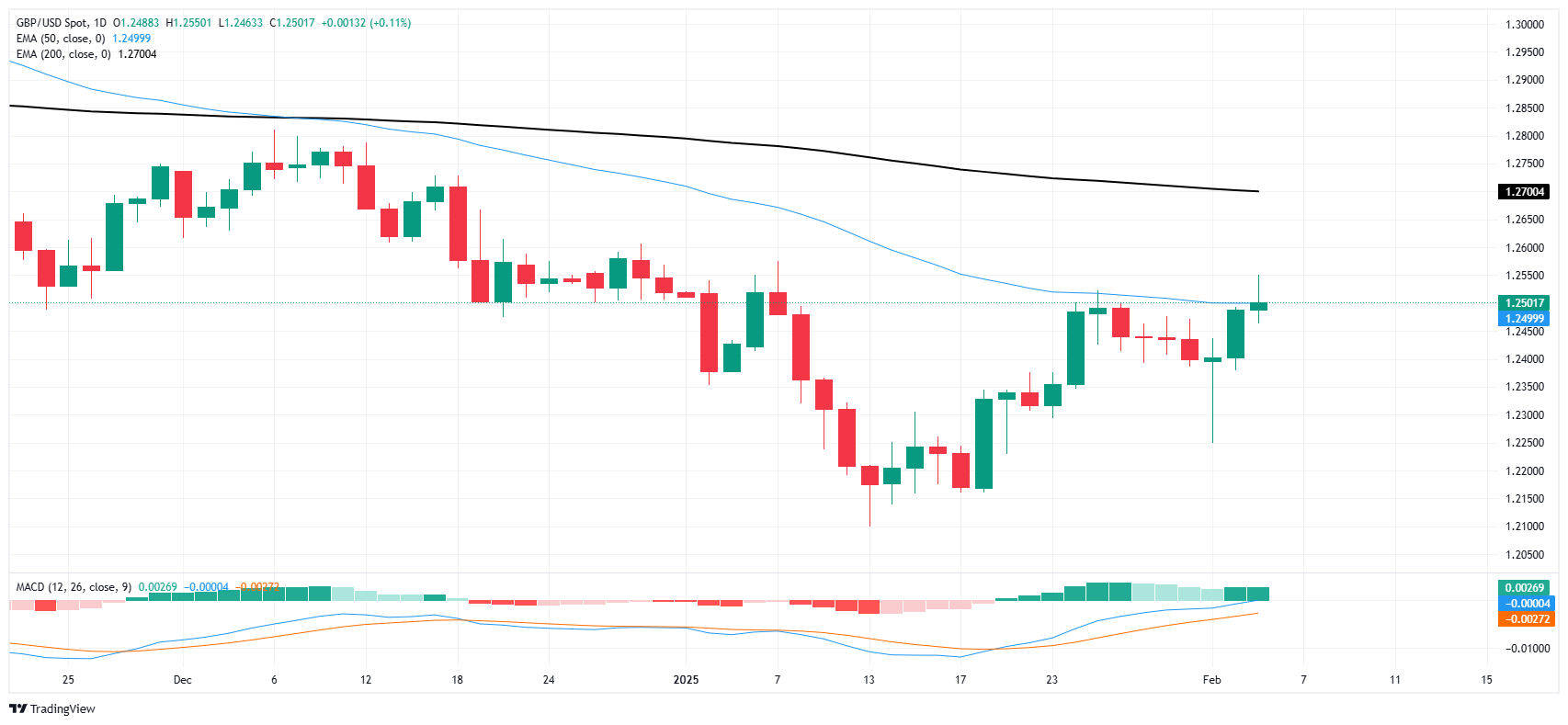GBP/USD cautiously bullish ahead of BoE rate call
- GBP/USD explored the high side on Wednesday but with little momentum.
- The pair remains constrained by key technical averages.
- BoE rate call due on Thursday, US NFP slated for Friday.
GBP/USD found some bidding action amid a broad-market easing in the Greenback. Market sentiment is drifting into the high end as investors recover from the early week’s trade war fears, and Cable traders are buckling down for the wait to the Bank of England’s (BoE) latest rate call.
US ADP Employment Change figures came in stronger than expected in January, showing a net increase of 183K in payrolls, beating the expected fall to 150K from December’s revised print of 176K. ADP job figures are a shaky forecast of US Nonfarm Payrolls (NFP) due at the end of the week, but the upswing is adding to investor confidence that the US economy remains on firm footing.
The BoE is widely expected to cut interest rates by 25 bps on Thursday. Median market forecasts expect the BoE’s Monetary Policy Committee (MPC) to vote eight-to-one to reduce interest rates to 4.5% from 4.75%, with the lone holdout expected to vote to keep interest rates steady for another meeting.
The key data print this week will be US NFP jobs additions on Friday. Investors expect January’s NFP print to ease to 170K from December’s print of 256K. Traders will also be keeping a close eye on revisions to previous months. Market participants hoping for rate cuts have been increasingly frustrated by the latent strength of the US economy, with labor figures routinely getting revised higher after the fact.
GBP/USD price forecast
Cable sprung higher on Wednesday, tapping a fresh three-week high of 1.2550, but price action was squeezed back to the middle. GBP/USD is getting hung up on the 50-day Exponential Moving Average (EMA) near the 1.2500 handle.
GBP/USD daily chart
Pound Sterling FAQs
The Pound Sterling (GBP) is the oldest currency in the world (886 AD) and the official currency of the United Kingdom. It is the fourth most traded unit for foreign exchange (FX) in the world, accounting for 12% of all transactions, averaging $630 billion a day, according to 2022 data. Its key trading pairs are GBP/USD, also known as ‘Cable’, which accounts for 11% of FX, GBP/JPY, or the ‘Dragon’ as it is known by traders (3%), and EUR/GBP (2%). The Pound Sterling is issued by the Bank of England (BoE).
The single most important factor influencing the value of the Pound Sterling is monetary policy decided by the Bank of England. The BoE bases its decisions on whether it has achieved its primary goal of “price stability” – a steady inflation rate of around 2%. Its primary tool for achieving this is the adjustment of interest rates. When inflation is too high, the BoE will try to rein it in by raising interest rates, making it more expensive for people and businesses to access credit. This is generally positive for GBP, as higher interest rates make the UK a more attractive place for global investors to park their money. When inflation falls too low it is a sign economic growth is slowing. In this scenario, the BoE will consider lowering interest rates to cheapen credit so businesses will borrow more to invest in growth-generating projects.
Data releases gauge the health of the economy and can impact the value of the Pound Sterling. Indicators such as GDP, Manufacturing and Services PMIs, and employment can all influence the direction of the GBP. A strong economy is good for Sterling. Not only does it attract more foreign investment but it may encourage the BoE to put up interest rates, which will directly strengthen GBP. Otherwise, if economic data is weak, the Pound Sterling is likely to fall.
Another significant data release for the Pound Sterling is the Trade Balance. This indicator measures the difference between what a country earns from its exports and what it spends on imports over a given period. If a country produces highly sought-after exports, its currency will benefit purely from the extra demand created from foreign buyers seeking to purchase these goods. Therefore, a positive net Trade Balance strengthens a currency and vice versa for a negative balance.

